ABS CHEVROLET BLAZER 1996 2.G Owners Manual
[x] Cancel search | Manufacturer: CHEVROLET, Model Year: 1996, Model line: BLAZER, Model: CHEVROLET BLAZER 1996 2.GPages: 392, PDF Size: 20.35 MB
Page 160 of 392
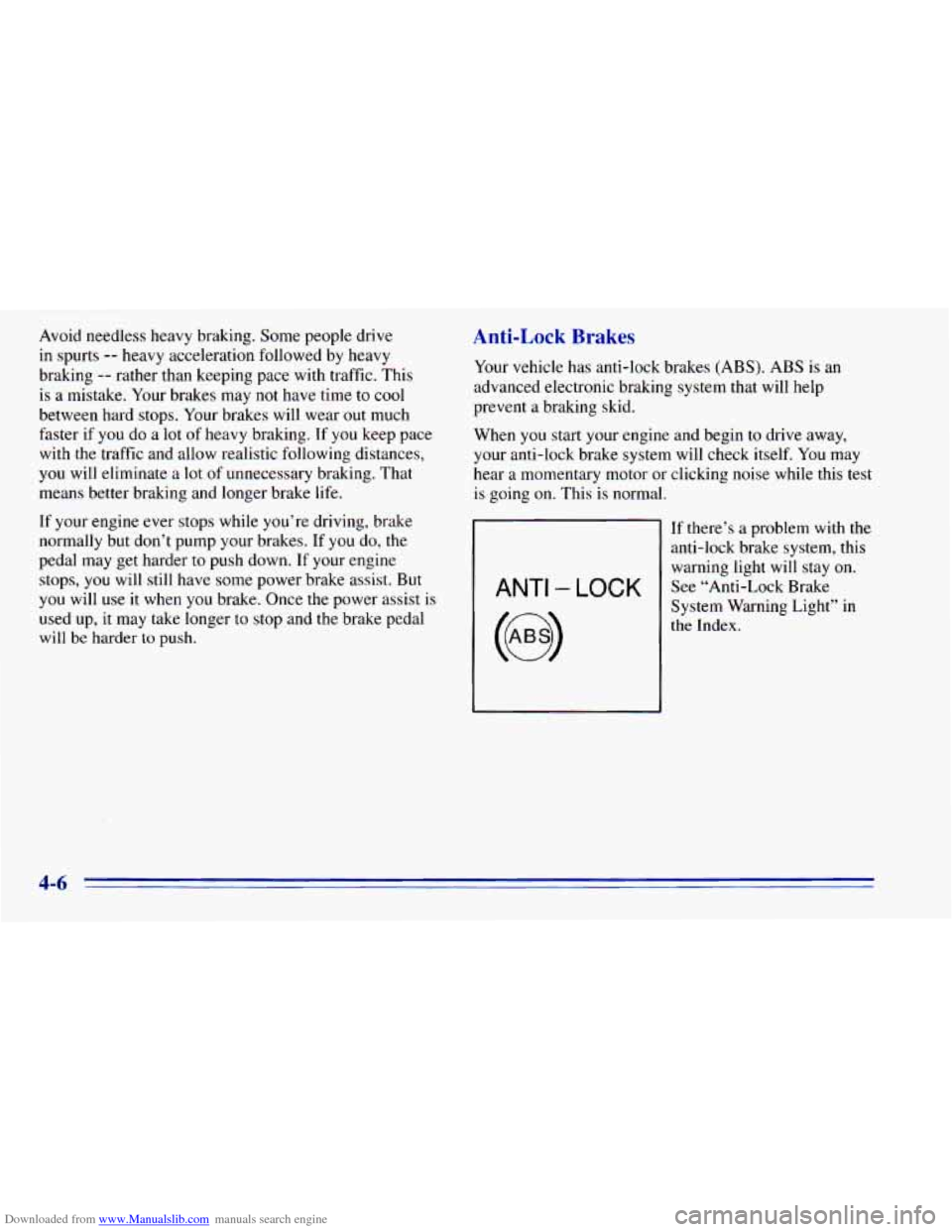
Downloaded from www.Manualslib.com manuals search engine Avoid needless heavy braking. Some people drive
in spurts -- heavy acceleration followed by heavy
braking
-- rather than keeping pace with traffic. This
is a mistake. Your brakes may not have time to cool
between hard stops. Your brakes will wear out much
faster if you do a lot
of heavy braking. If you keep pace
with the traffic and allow realistic following distances,
you will eliminate a lot of unnecessary braking. That
means better braking and longer brake life.
If your engine ever stops while you’re driving, brake
normally but don’t pump your brakes. If
you do, the
pedal may get harder
to push down. If your engine
stops,
you will still have some power brake assist. But
you will use it when you brake. Once the power assist is
used up, it may take longer to stop and the brake pedal
will be harder to push.
Anti-Lock Brakes
Your vehicle has anti-lock brakes (ABS). ABS is an
advanced electronic braking system that will help
prevent a braking skid.
When
you start your engine and begin to drive away,
your anti-lock brake system will check itself.
You may
hear a momentary motor or clicking noise while this test
is going on. This
is normal.
ANTI - LOCK
If there’s a problem with the
anti-lock brake system, this
warning light will stay on. See “Anti-Lock Brake
System Warning Light” in
the Index.
4-6
Page 161 of 392
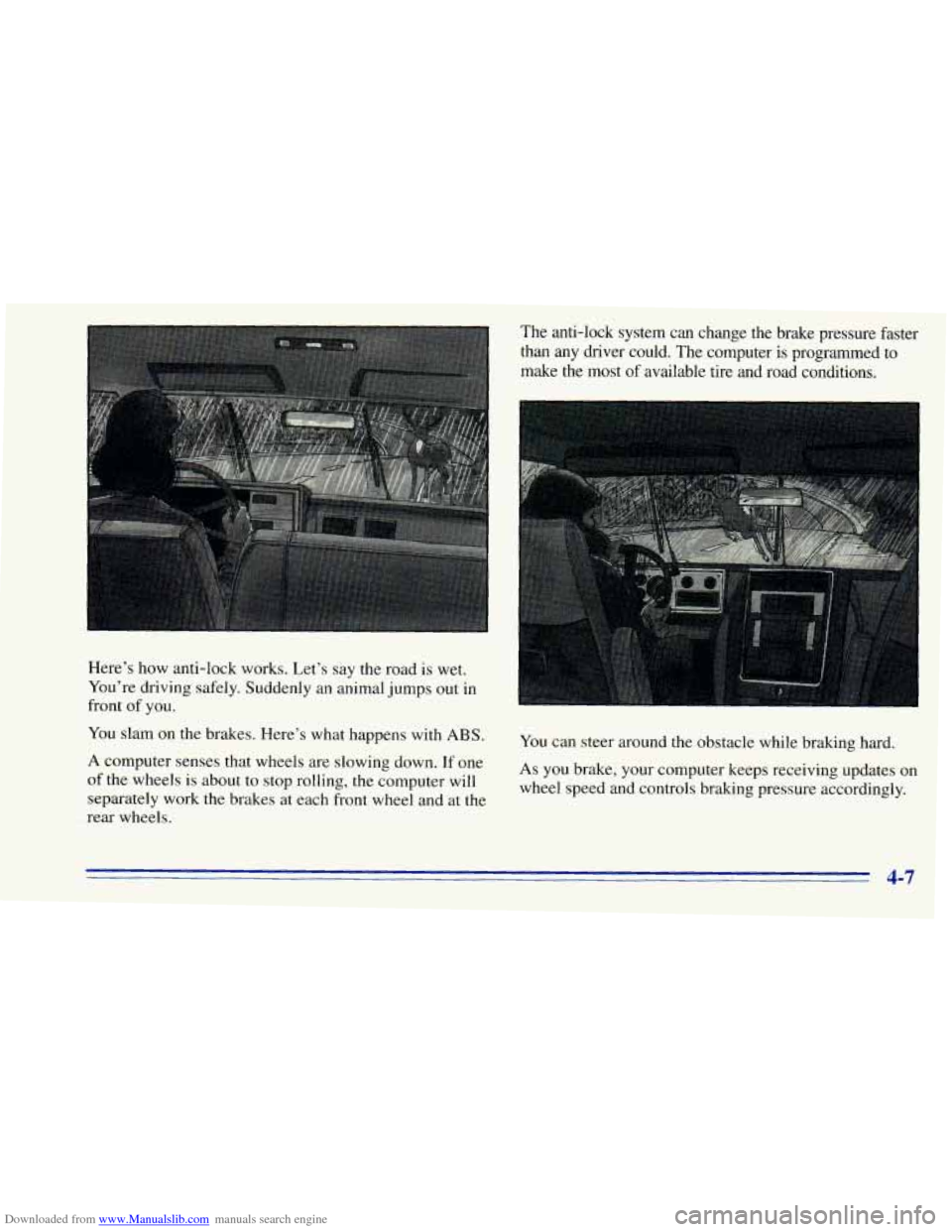
Downloaded from www.Manualslib.com manuals search engine The anti-lock system can change the brake pressure faster
than any driver could. The computer
is programmed to
make the most
of available tire and road conditions.
Here’s how anti-lock works. Let’s say the road is wet.
You’re driving safely. Suddenly an animal jumps out in
front
of you.
You slam
on the brakes. Here’s what happens with ABS.
A computer senses that wheels are slowing down. If one
of the wheels
is about to stop rolling, the computer will
separately work the brakes at each front wheel and at the
rear wheels. You
can steer around the obstacle while braking hard. As you brake, your computer keeps receiving updates on
wheel speed and controls braking pressure accordingly.
4-7
Page 167 of 392
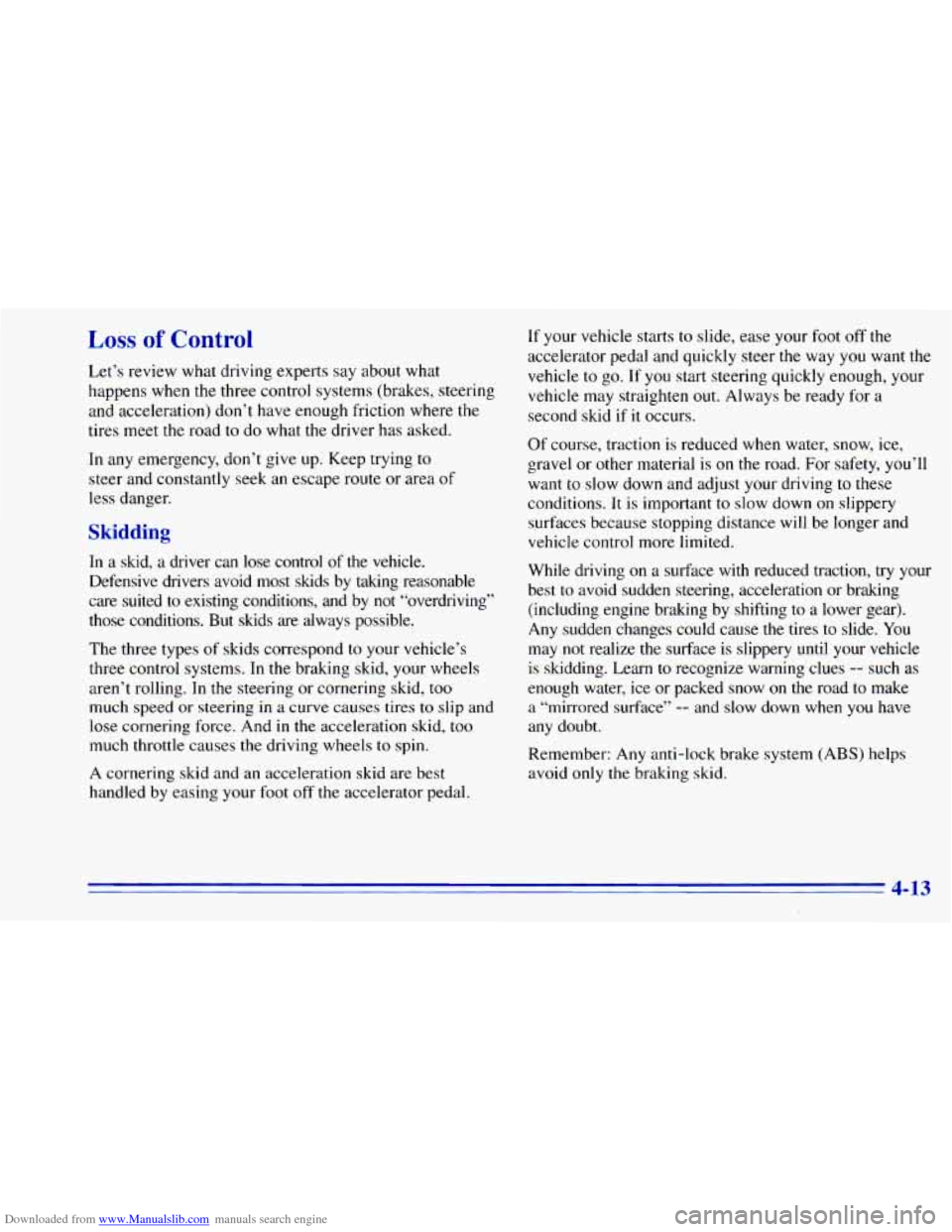
Downloaded from www.Manualslib.com manuals search engine Loss of Control
Let’s review what driving experts say about what
happens when the three control systems (brakes, steering
and acceleration) don’t have enough friction where the
tires meet
the road to do what the driver has asked.
In any emergency, don’t give up. Keep trying to
steer and constantly seek
an escape route or area of
less danger.
Skidding
In a skid, a driver can lose control of the vehicle.
Defensive drivers avoid most skids by taking reasonable
care suited to existing conditions, and by not “overdriving”
those conditions. But skids are always possible.
The three types
of skids correspond to your vehicle’s
three control systems.
In the braking skid, your wheels
aren’t rolling. In
the steering or cornering skid, too
much speed or steering
in a curve causes tires to slip and
lose cornering force. And
in the acceleration skid, too
much throttle causes the driving wheels to spin.
A cornering skid and an acceleration skid are best
handled by easing your foot off
the accelerator pedal.
If your vehicle starts to slide, ease your foot off the
accelerator pedal and quickly steer the way you want the
vehicle to go.
If you start steering quickly enough, your
vehicle may straighten out. Always be ready for a
second
skid if it occurs.
Of course, traction is reduced when water, snow, ice,
gravel or other material is on the road. For safety, you’ll
want to slow down and adjust your driving to these
conditions. It is important to slow down on slippery
surfaces because stopping distance
will be longer and
vehicle control more limited.
While driving on
a surface with reduced traction, try your
best
to avoid sudden steering, acceleration or braking
(including engine braking
by shifting to a lower gear).
Any sudden changes could cause the tires to slide. You
may not realize
the surface is slippery until your vehicle
is skidding. Learn to recognize warning clues
-- such as
enough water, ice or packed snow on the road to make
a “mirrored surface” -- and slow down when you have
any doubt.
Remember:
Any anti-lock brake system (ABS) helps
avoid only the braking skid.
4-13
Page 208 of 392
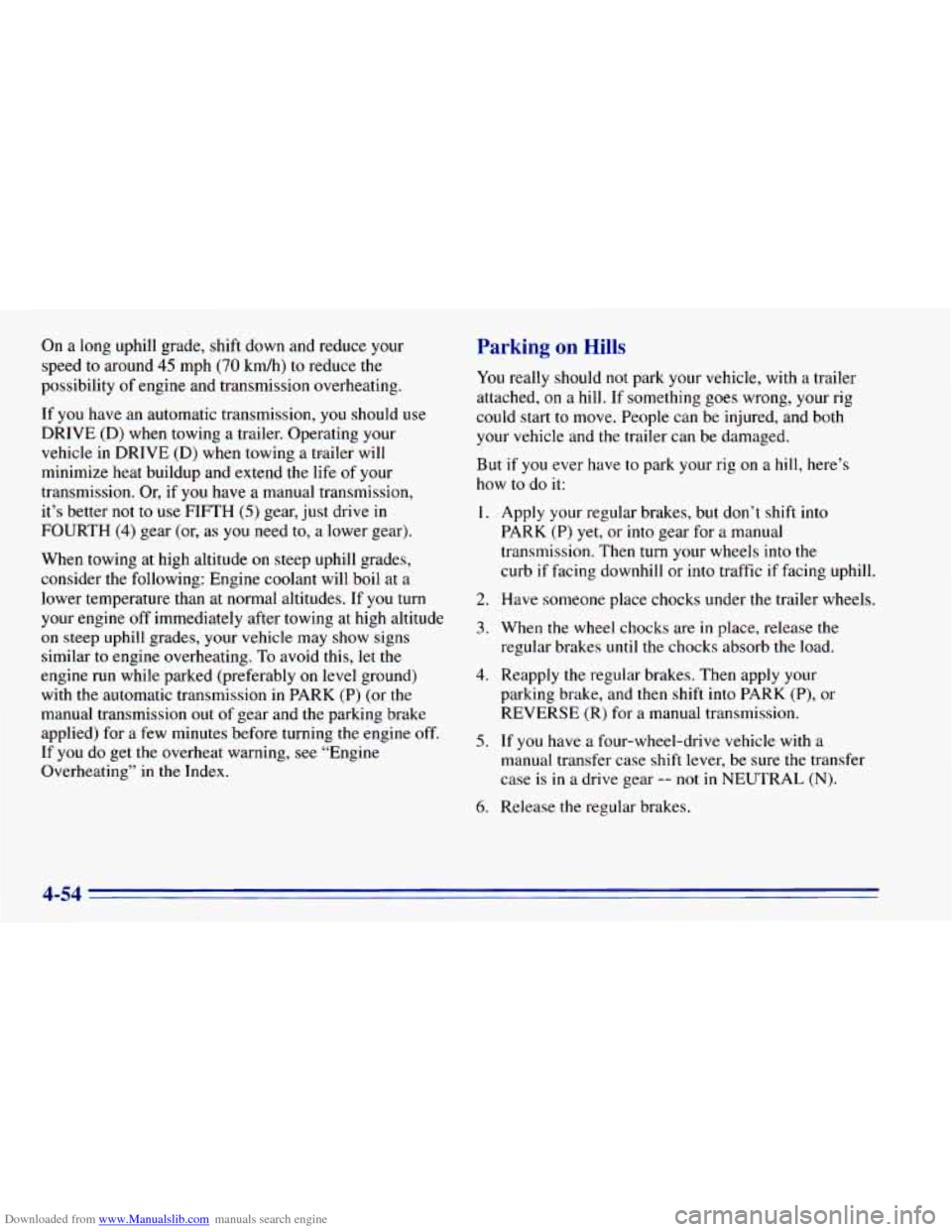
Downloaded from www.Manualslib.com manuals search engine On a long uphill grade, shift down and reduce your
speed to around
45 mph (70 kmh) to reduce the
possibility of engine and transmission overheating.
If you have
an automatic transmission, you should use
DRIVE (D) when towing
a trailer. Operating your
vehicle in DRIVE
(D) when towing a.trailer will
minimize heat buildup and extend the life of your
transmission. Or, if
you have a manual transmission,
it’s better not to use FIFTH
(5) gear, just drive in
FOURTH (4) gear (or, as you need to, a lower gear).
When towing at high altitude
on steep uphill grades,
consider the following: Engine coolant will boil at a
lower temperature than at normal altitudes. If you turn
your engine off immediately after towing at high altitude
on steep uphill grades, your vehicle may show signs
similar to engine overheating.
To avoid this, let the
engine run while parked (preferably on level ground)
with the automatic transmission in PARK
(P) (or the
manual transmission
out of gear and the parking brake
applied) for a few minutes before turning the engine off.
If
you do get the overheat warning, see “Engine
Overheating” in the Index.
Parking on Hills
You really should not park your vehicle, with a trailer
attached,
on a hill. If something goes wrong, your rig
could start to move. People can be injured, and both
your vehicle and the trailer can be damaged.
But
if you ever have to park your rig on a hill, here’s
how to
do it:
1.
2.
3.
4.
5.
6.
Apply your regular brakes, but don’t shift into
PARK
(P) yet, or into gear for a manual
transmission. Then turn your wheels into the
curb
if facing downhill or into traffic if facing uphill.
Have someone place chocks under the trailer wheels.
When the wheel chocks are
in place, release the
regular brakes
until the chocks absorb the load.
Reapply the regular brakes.
Then apply your
parking brake, and then shift into PARK (P), or
REVERSE
(R) for a manual transmission.
If
you have a four-wheel-drive vehicle with a
manual transfer case shift lever, be sure the transfer
case is
in a drive gear -- not in NEUTRAL (N).
Release the regular brakes.
4-54
Page 284 of 392
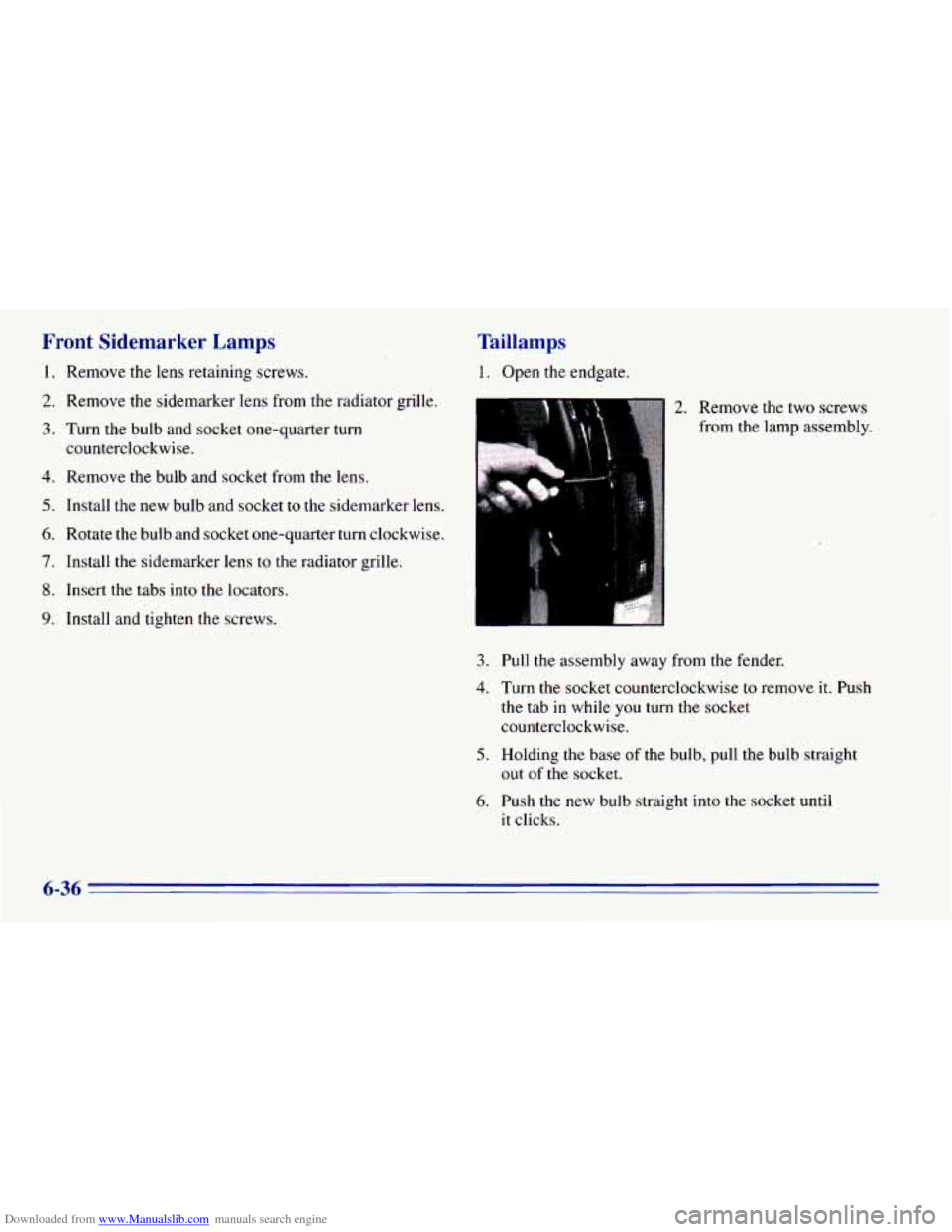
Downloaded from www.Manualslib.com manuals search engine Front Sidemarker Lamps
1. Remove the lens retaining screws.
2. Remove the sidemarker lens from the radiator grille.
3. Turn the bulb and socket one-quarter turn
4. Remove the bulb and socket from the lens.
5. Install the new bulb and socket to the sidemarker lens.
6. Rotate the bulb and socket one-quarter turn clockwise.
7. Install the sidemarker lens to the radiator grille.
8. Insert the tabs into the locators.
counterclockwise.
9. Install and
tighten the screws.
Taillamps
1. Open the endgate.
2. Remove the two screws
from the lamp assembly.
3. Pull the assembly away from me fender.
4. Turn the socket counterclockwise to remove it. Push
the tab
in while you turn the socket
counterclockwise.
5. Holding the base of the bulb, pull the bulb straight
out of the socket.
6. Push the new bulb straight into the socket until
it clicks.
6-36
Page 286 of 392
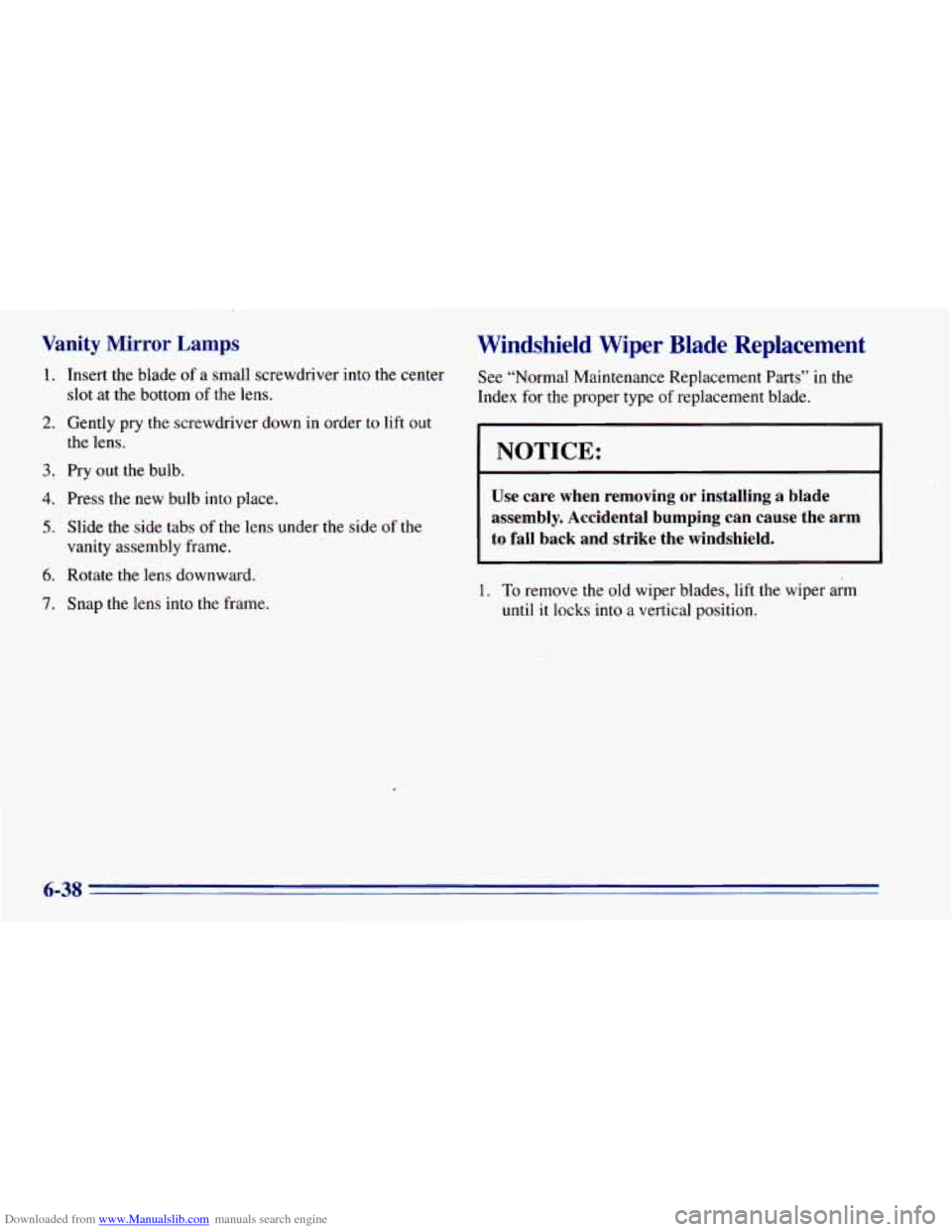
Downloaded from www.Manualslib.com manuals search engine Vanity Mirror Lamps
1.
2.
3.
4.
5.
6.
7.
Insert the blade of a small screwdriver into the center
slot at the bottom
of the lens.
Gently pry the screwdriver down in order to lift out
the lens.
Pry out the bulb.
Press the new bulb into place.
Slide the side tabs
of the lens under the side of the
vanity assembly frame.
Rotate the lens downward.
Snap the lens into
the frame.
Windshield Wiper Blade Replacement
See “Normal Maintenance Replacement Parts” in the
Index for the proper type
of replacement blade.
I NOTICE:
Use care when removing or installing a blade
assembly. Accidental bumping can cause the
arm
to fall back and strike the windshield.
1. To remove the old wiper blades, lift the wiper arm
until it locks into a vertical position.
6-38
Page 304 of 392
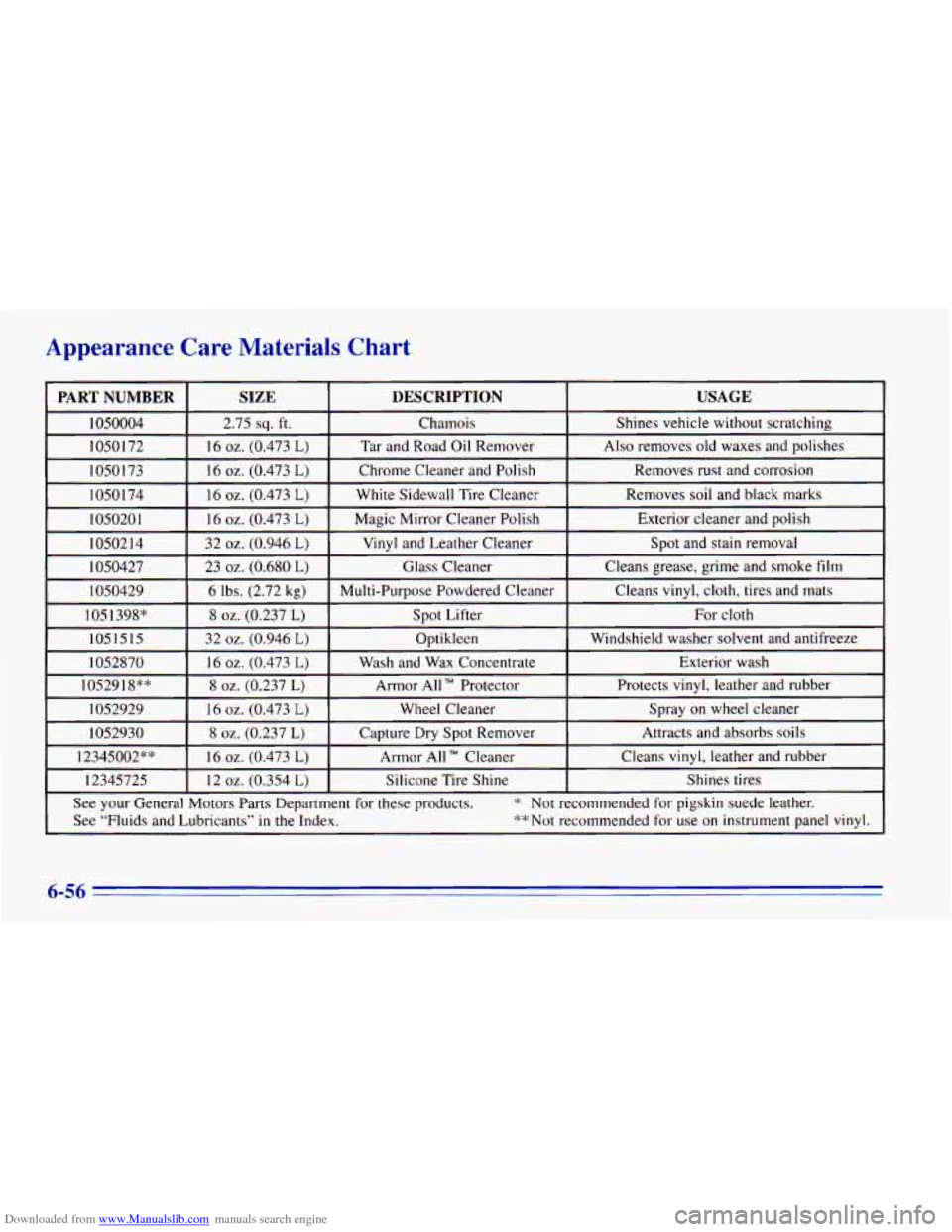
Downloaded from www.Manualslib.com manuals search engine Appearance Care Materials Chart
I PARTNUMBER I SIZE I DESCRIPTION I USAGE I
1050004 16 oz. (0.473 L)
1050 I72 Shines vehicle without scratching
Chamois
2.75
sq. ft.
Cleans
vinvl, cloth, tires and mats
Multi-Purpose Powdered Cleaner 6 Ibs. (2.72 kg) 1050429 Cleans grease, grime and
smoke film
Glass Cleaner
23
oz. (0.680 L) 1050427 Spot and stain removal
Vinyl and Leather Cleaner
32 oz. (0.946 L)
10502 14 Exterior cleaner and polish
Magic Mirror Cleaner Polish
16
oz. (0.473 L) 1 05020 1
Removes soil and black marks White Sidewall Tire Cleaner
16 oz. (0.473 L) 1050 174 Removes rust and corrosion
Chrome Cleaner and Polish 16
oz. (0.473 L)
1050173
Also removes old waxes and polishes
Tar and Road Oil Remover
I
I -. I I 4
105 1398“ I 8 oz. (0.237
L) I Spot Lifter I For cloth I
1051515 32 oz. (0.946 L) Optikleen Windshield washer solvent and antifreeze
1052870 16 oz. (0.473 L) Wash and Wax
Concentrate Exterior wash
1052918””
8 oz. (0.237 L) Armor All TM Protector Protects vinyl, leather and rubber
I 1052929 I 16 oz. (0.473 L) I Wheel Cleaner I Spray on wheel cleaner I Ir
1052930
12345002** 16
oz. (0.473 L) Armor All TM Cleaner Cleans vinyl, leather and rubber
Attracts and absorbs
soils Capture Dry Spot Remover 8 oz. (0.237 L)
I I I
I 12345725 I 12
oz. (0.354 L) I Silicone Tire Shine I Shines tires I I I I
See your General Motors Parts Department for these products. * Not recommended for pigskin suede leather.
See “Fluids and Lubricants’’
in the Index. **Not
recommended for use on instrument panel vinyl.
6-56
Page 309 of 392
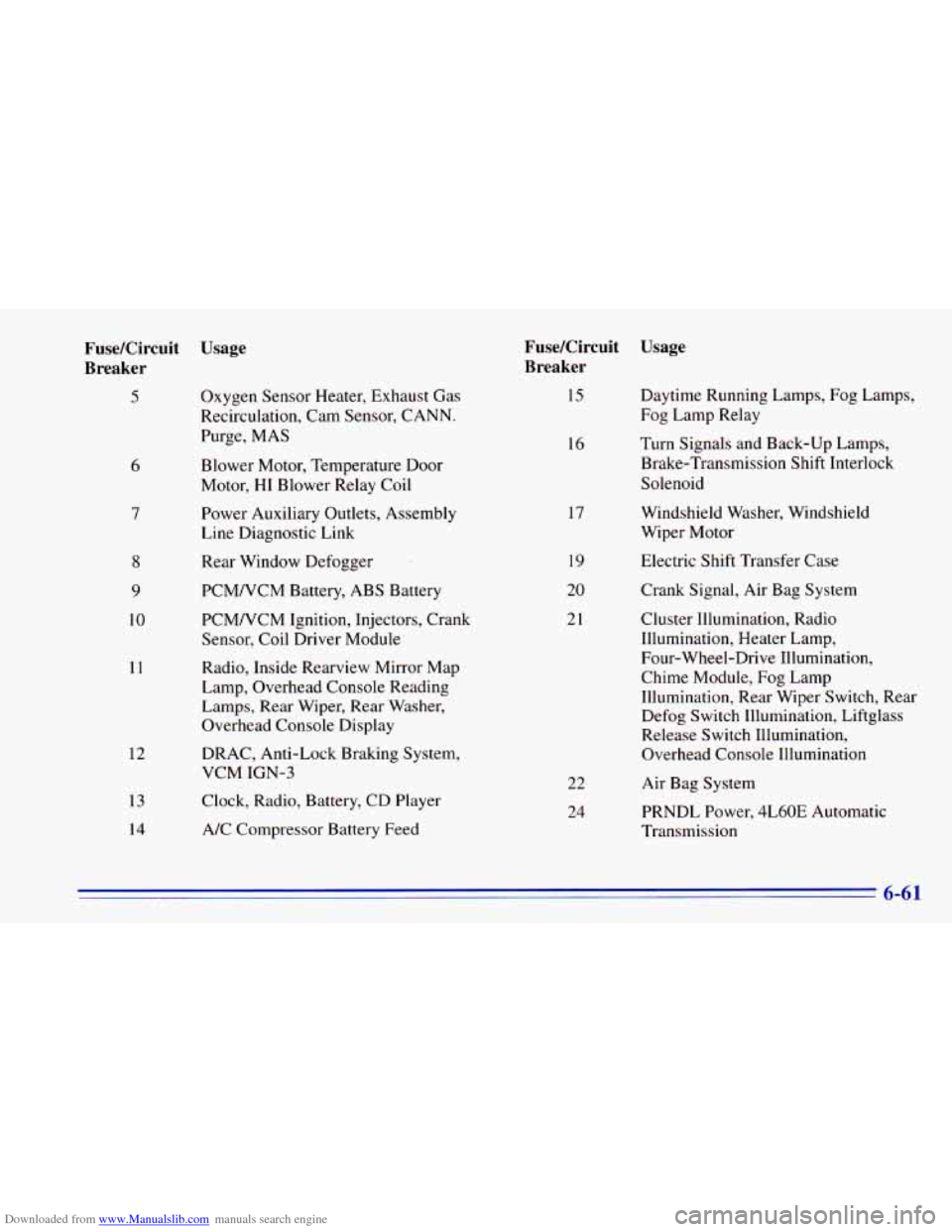
Downloaded from www.Manualslib.com manuals search engine FuseKircuit Usage
Breaker
5
7
8
9
10
11
Oxygen Sensor Heater, Exhaust Gas
Recirculation, Cam Sensor, CANN.
Purge, MAS
Blower Motor, Temperature Door
Motor, HI Blower Relay Coil
Power Auxiliary Outlets, Assembly
Line Diagnostic Link
Rear Window Defogger
PCMNCM Battery, ABS Battery
PCMNCM Ignition, Injectors, Crank
Sensor, Coil Driver Module
Radio, Inside Rearview Mirror Map
Lamp, Overhead Console Reading
Lamps, Rear Wiper, Rear Washer,
Overhead Console Display
12 DRAC, Anti-Lock Braking System, VCM IGN-3
13
14
Clock, Radio, Battery, CD Player
A/C Compressor Battery Feed
FuseKircuit Usage
Breaker
15
16
17
19
20
21
22 24 Daytime Running Lamps,
Fog Lamps,
Fog Lamp Relay
Turn Signals and Back-up Lamps,
Brake-Transmission Shift Interlock
Solenoid
Windshield Washer, Windshield
Wiper Motor
Electric Shift Transfer Case
Crank Signal, Air Bag System
Cluster Illumination, Radio
Illumination, Heater Lamp, Four-Wheel-Drive Illumination,
Chime Module, Fog Lamp
Illumination, Rear Wiper Switch, Rear
Defog Switch Illumination, Liftglass
Release Switch Illumination,
Overhead Console Illumination
Air Bag System
PRNDL Power, 4L60E Automatic
Transmission
6-61